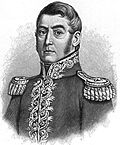List of symbols
| Symbol | Image | Description |
|---|---|---|
| National flag [2] |  Flag of Argentina | It consists of three, equal in width, horizontal stripes, colored light blue, white and light blue, with the Sun of May in the center of the middle, white stripe. The flag was designed by Manuel Belgrano in 1812; it was adopted as a national symbol 20 July 1816. |
| Coat of arms [2] |  Coat of arms of Argentina | It was established in its current form in 1944, but has its origins in the seal of the General Constituent Assembly of 1813. At the top we find the gold-yellowed Sun of May. The coat of arms symbolizes the rising of Argentina, the unity of the provinces of Argentina, power and willingness to defend freedom. |
| Cockade [2] |  Cockade of Argentina | It was instituted by decree on February 18, 1812, by the First Triumvirate. The cockade was first used by the ladies of Buenos Aires during the events of the 1810 May Revolution. On February 18, 1812, the government decided to create the national cockade of the United Provinces of the Río de la Plata with light blue at its outer border and centre, and white between both. Belgrano then used the same colours to design the national flag. |
| Sun of May [3] |  | The Sun of May is a representation of the Inca sun god Inti. [4] The sun, called the Sun of May, is engraved on an 1828 eight escudo, the first Argentine coin, approved in 1813 by the Constituent Assembly. It features 32 rays, 16 undulated and 16 straight in alternation, and since 1978 it must be embroidered in the official ceremonial flag. |
| National anthem [2] |  "Himno Nacional Argentino" (Argentine National Anthem) | The Argentine National Anthem, adopted in 1813, was written by Vicente López y Planes with music by Blas Parera. It has been subsequently shortened to only three paragraphs, after omitting the lyrics' attacks against former occupant Spain. Performance of the anthem is mandatory during all official events, and Argentines in attendance are expected to stand up and sing it. |
| Motto [5] | En unión y libertad (In unity and freedom) | It was set in the 1813 General Assembly, [5] during the War of Independence of the United Provinces of the Río de la Plata from the Spanish Empire. It can be seen in all peso coins and banknotes currently in circulation. |
| Logo [6] |  Logo of Argentina | It came from the Contest for the Visual Identity of the Argentina Brand, which took place in 2006. [6] Through the presidential decree 1372/2008, the logo representing Argentina abroad became official. [7] |
| Father of the Fatherland [8] |  José de San Martín | |
| National colours | Sky blue White Gold Blue (secondary) | |
| National personification |  Effigy of the Republic/Liberty/Progress/Fatherland | |
 Gaucho | ||
| National tree [1] [9] |  Ceibo | |
 Red Quebracho | ||
| Floral emblem [1] |  Ceibo flower | |
| National animal/National bird [10] |  Hornero | |
| National gemstone [1] |  Rhodochrosite | |
| National sport [1] |  Pato | |
| National liquor [11] |  Wine | |
| National infusion [12] |  Mate | |
| National dish [13] [14] |  Asado | |
 Locro | ||
| Patron saint [15] | Our Lady of Luján |